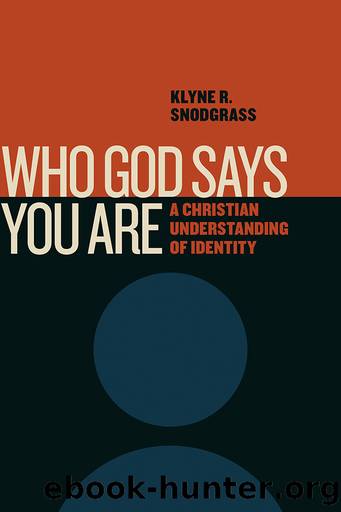Who God Says You Are: a Christian Understanding of Identity by Klyne R. Snodgrass

Author:Klyne R. Snodgrass
Language: eng
Format: epub
Publisher: Eerdmans
1. Walther Eichrodt, Man in the Old Testament, trans. K. Smith and R. Gregor Smith, Studies in Biblical Theology (London: SCM, 1951), 9.
2. Patrick McNamara, The Neuroscience of Religious Experience (Cambridge: Cambridge University Press, 2009), 5, 30â32, 40â42, and 147â51.
3. See Augustine, Confessions 10.8.13â14 and 10.24â25.35â36. See also 3.6 and the discussion in Charles Taylor, Sources of the Self: The Making of the Modern Identity (Cambridge, MA: Harvard University Press, 1989), 135â36.
4. Binsar Pakpahan, âIdentity and Remembrance,â in Christian Identity, ed. Eduardus Van der Borght, Studies in Reformed Theology 16 (Leiden: Brill, 2008), 105â17, 108.
5. The NIV has âYet you desired faithfulness even in the womb.â While the Hebrew word âemet includes ideas of both âtruthâ and âfaithfulness,â this translation is odd. The parallelism with the second part of the verse shows the focus is on understanding in the inner being.
6. Private communication.
7. Carl Elliott, Better Than Well: American Medicine Meets the American Dream (New York: Norton, 2003), 41.
8. Taylor, Sources of the Self, 47: âto make minimal sense of our lives, in order to have an identity, we need an orientation to the good.â
9. Sentences of Sextus 56.
10. âRhinestone Cowboy.â
11. See Søren Kierkegaard, Purity of Heart Is to Will One Thing, trans. Douglas V. Steere (New York: Harper and Row, 1938), 141.
12. On guilt, see Patrick McNamara, Spirit Possession and Exorcism: History, Psychology, and Neurobiology, 2 vols. (Santa Barbara, CA: Praeger, 2011), 1:34â43.
13. Note Paul Ricoeur, âThe Summoned Subject in the School of the Narratives of the Prophetic Vocation,â in Figuring the Sacred: Religion, Narrative, and Imagination, trans. David Pellauer, ed. Mark I. Wallace (Minneapolis: Fortress, 1995), 262â75, esp. 271 and 274: âConscience is fundamentally a principle of individuation rather than an instance of accusation and judgment . . . the call of conscience is a call of the self to itself. . . . The Christian is someone who discerns âconformity to the image of Christâ in the call of conscience.â
14. Tim Stafford, âA Heaven-Made Activist,â Christianity Today, January 2004, 46â50, here 50.
15. W. H. Auden, âA Christmas Oratorio,â in For the Time Being (London: Faber and Faber, 1945), 61â124, here 66.
16. Emmanuel Levinas, with his emphasis on the significance of the face of the other person, wrote, âAccess to the face is straightaway ethicalâ (Ethics and Infinity: Conversations with Philippe Nemo [Pittsburgh: Duquesne University Press, 1982], 85). Paul Ricoeur extended Levinasâs point by saying, âEach face is a Sinai that prohibits murderâ (Oneself as Another, trans. Kathleen Blamey [Chicago: University of Chicago Press, 1992], 336). See p. 90 above.
17. Chaim Potok, In the Beginning (New York: Fawcett, 1975), 381.
18. See Nils Dahl, âAnamnesis,â in Dahl, Jesus in the Memory of the Early Church: Essays (Minneapolis: Augsburg, 1976), 11â29. Cf. Deut. 5:3 and Mishnah Pesahim 10:5.
19. The tension between this text and Eph. 2:11, where Paul urges his readers to remember their past, is only superficial. Both texts urge Christ as the ultimate determiner of identity.
20. See Rom. 12:2; 14:22; 1 Cor. 11:28; Gal. 6:4; Eph. 5:10; and 1 Thess.
Download
This site does not store any files on its server. We only index and link to content provided by other sites. Please contact the content providers to delete copyright contents if any and email us, we'll remove relevant links or contents immediately.
Signature in the Cell: DNA and the Evidence for Intelligent Design by Stephen C. Meyer(3058)
Real Sex by Lauren F. Winner(2950)
The Secret Power of Speaking God's Word by Joyce Meyer(2932)
The Holy Spirit by Billy Graham(2881)
The Gnostic Gospels by Pagels Elaine(2459)
Jesus by Paul Johnson(2294)
Devil, The by Almond Philip C(2268)
23:27 by H. L. Roberts(2186)
The Nativity by Geza Vermes(2165)
Chosen by God by R. C. Sproul(2114)
All Things New by John Eldredge(2094)
Angels of God: The Bible, the Church and the Heavenly Hosts by Mike Aquilina(1916)
The Return of the Gods by Erich von Daniken(1886)
Angels by Billy Graham(1877)
Knowing God by J.I. Packer(1795)
Jesus of Nazareth by Joseph Ratzinger(1754)
Evidence of the Afterlife by Jeffrey Long(1735)
The Gnostic Gospel of St. Thomas by Tau Malachi(1726)
How To Be Born Again by Billy Graham(1720)
